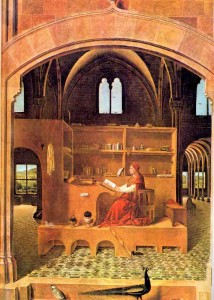
My desk had been cleared. It’s a small, light-colored office model with a chipboard top and steel legs, and it blended nicely with its surroundings. Beside the glass with the sawdust in it, there is an elongated piece of wood with holes at one end, rounded edges, and slanting grooves of varying width–a so-called hand fondler, carved years ago by my son (more or less as a school exercise), blackened from handling, but still smelling of fresh wood, just as the brown, fist-sized, hardened lump of clay beside it, whenever I pick it up, takes on the smell of the damp gully from which it was taken years ago….
All these objects might be termed my “callers to order,” because, by pleasantly diverting me now and again, they save me from losing myself entirely in my work.
My friend Simon gave me Across by Peter Handke a while ago now and this passage about the writer’s desk stayed with me. I think I’m attuned to words about objects. Around the same time I read Thoughts of Sorts by Georges Perec. In it he describes the objects on his desk and the place in which he thinks.
My friend Louisa Minkin made a great piece called The Study of St Jerome after Saint Antonello Da Messina where by an MDF interpretation of the desk from the painting staged performances and artworks by other artists.
Callers to order, philosopher’a stones, desks and writing cases; all are brought together in Brian Dillon’s text for Frieze:
As the novelist Georges Perec – who later composed an essay on the objects on his desk – points out in Species of Spaces (1974), the study is itself a piece of furniture: Jerome inhabits his desk as though it is the cockpit of an interplanetary vehicle, adrift in theological space and time.
Is Noticer an interplanetary vehicle?
I notice a series of connections here, as though this post is gathering ideas to it, generously, obediently modeling a magnetic quality. The sensation is persuasive, a dim memory, a ready awakening, a sense of the familiar, something/s known but momentarily beyond reach. It compels a searching. Following. The opening of books to discover the misremembered and the re-invented along with the ideas that have become your friends and allies.
Your inclusion of the Antonella da Messina image and Louisa’s platform resonant in many ways, both image and object have made their way in to so many conversations.
The following is a section from a text written to accompany Interior Life, an exhibition Tash was in.
In Antonella da Messina’s painting St Jerome in his Study the study in question comprises a space within a space: a wooden platform housing the saint and the paraphernalia of his study is itself located within the expanse of the imposing architecture of a cathedral which stretches above and beyond. Of this configuration of the saint’s study Georges Perec notes that it represents the inhabitable in the midst of the uninhabitable. ‘The whole space is organized around the piece of furniture (and the whole piece of furni- ture is organized around the book). The glacial architecture of the church … has been cancelled out …. Surrounded by the uninhabitable, the study defines a domesticated space inhabited with serenity by cats, books and men.’7 The inhabitable interior is produced not by the architecture that protects against the external elements but by this piece of ‘furniture’ around which the saint’s activity is oriented and from which his serenity is derived.
Bernice Donszelmann, Interior Life
Accompanying exhibition of same name at Herbert Read Gallery, Kent
Perec appears again, probably not for the last time …. As do references to desks, working spaces and furniture!